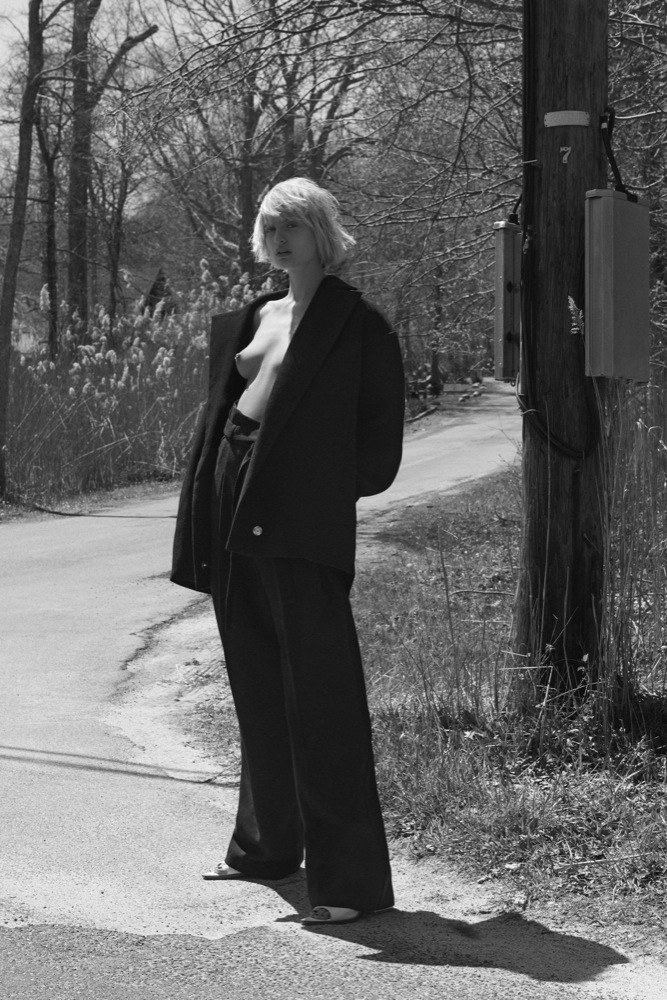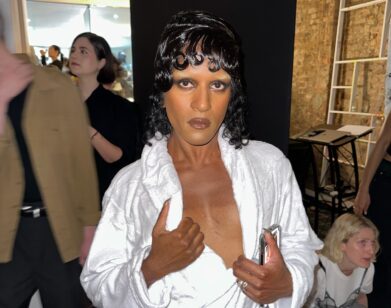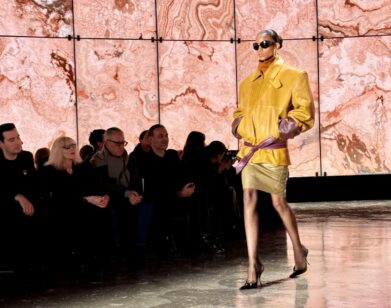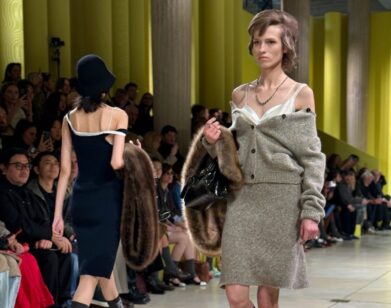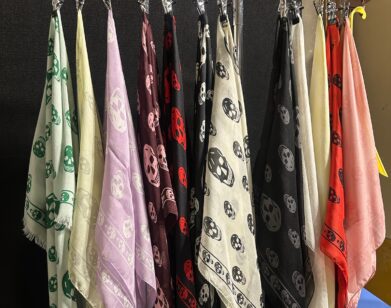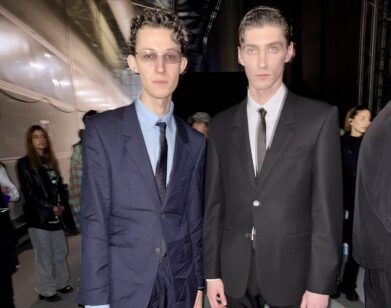Adventures in A.W.A.K.E.
PHOTOS: HANS NEUMANN. STYLING: TALLULAH HARLECH/PRINT AND CONTACT. HAIR: JOEY GEORGE/THE WALL GROUP USING ORIBE. MAKEUP: PEP GAY/STREETERS. MODEL: VERONIKA VILIM/WILHELMINA. CASTING: DAVID CHEN.
In 2012, former fashion editor Natalia Alaverdian launched her womenswear label A.W.A.K.E. An acronym for “all wonderful adventures kindle enthusiasm,” the label’s name reflects Alaverdian’s animal-inspired, fanciful collections of artistically deconstructed ankle-length skirts and dresses, and puff sleeved or batwing blouses. Based in London, A.W.A.K.E. already has a strong following, with stockists including directional boutiques and department stores such as Browns, MatchesFashion.com, and Harrods. There are, of course, famous fans of the brand—Kanye West purportedly introduced Kim Kardashian to the label—but Alaverdian isn’t after celebrities. “It’s always very exciting when celebrities wear your stuff,” she says over the phone. “But the people that you don’t know, when they wear your stuff, it’s more exciting.”
Here, Alaverdian talks to A.W.A.K.E. enthusiast Veronika Vilim. A model and aspiring actress, you may recognize Vilim from her recent Saint Laurent campaign, runway shows for the likes of Lanvin and Moschino, and even Interview editorials.
VERONIKA VILIM: You were born in Russia and raised in Belgium. How was it growing up in two different cultures? Are your parents artists?
NATALIA ALAVERDIAN: I suppose I soaked in quite a lot of Soviet culture. I was born in 1981, and of course it was the Soviet Union. It was that mix of Soviet Russian culture—old perfumes, old movies. Soviet movies are pretty amazing. My mom was an amazing illustrator. Naturally she drew so well. She could draw anything. I remember as a child we would sit together and she would sketch whatever I asked her to sketch or random funny sketches of people—she was really good at sketching people—and I think that brought up this passion in me as well. I loved drawing and illustrating and sketching, and that’s where the fashion stuff started. Also, my mom used to make my clothes for me and my brother. She would make all my costumes for school plays; I would be a gypsie and then a Lambada dancer, and she would make them all herself and invent them herself. I think that influenced me a lot. Also, as a child I would listen to a lot of fairy tales because in Russia, back then…
VILIM: You didn’t have much, right? You didn’t have fashion magazines and stuff like that?
ALAVERDIAN: Exactly. Nothing like that. We had this really funny fashion magazine coming from Germany called Burda Moden. It had all these patterns inside and you could take those patterns and make stuff yourself. We didn’t have a lot of cartoons; we only had Soviet cartoons, which were pretty awesome. We never saw any American cartoons and I’d never heard of Disney until I was, like, 10. No foreign television at all. It was really crazy. So I would listen to all of these fairy tales on records—there would be different voices playing different characters, and I was absolutely fascinated with that. My grandmother would also read me fairy tales when I was eating, because I would refuse to eat without someone reading me a fairy tale. [laughs] Later on, when I was 10 and the Berlin Wall fell and all of those things, my dad traveled abroad and he brought me all these Barbies. I loved dressing them and making clothes for them. I never had that before.
VILIM: I was obsessed with Barbies as well. I never designed clothing for Barbies, I would just use anything—different color duct tape and wrap it around the Barbie. Speaking of that, do you remember the first item of clothing you designed?
ALAVERDIAN: I don’t remember. It was something for a Barbie, definitely. I would give them haircuts.
VILIM: Me too.
ALAVERDIAN: I was absolutely, completely Barbie obsessed. There was this alternative for Barbies as well—they were called Cindy or something like that. It was this parallel universe of those crazy dolls. Then I moved to Belgium when I was 12.
VILIM: That must have been a huge culture shock.
ALAVERDIAN: I was too small to think of it as a big cultural transition and really understand it. Russia was already transitioning in a way, especially Moscow, and I would travel already with my parents.
VILIM: So you already knew what it was like outside of Russia.
ALAVERDIAN: Yeah. So it was a smoother transition.
VILIM: So you were working at Harper’s Bazaar in Russia before you started doing fashion design.
ALAVERDIAN: Yes. I always wanted to do fashion design. When I went to pattern cutting courses, I messed up everything in terms of figures and numbers, because I’m really messy, and you need your measurements and you need to have them correctly. I would turn shorts into a skirt or something, because I wouldn’t follow the measurements. Then I got so scared I thought, “I’ll just do the styling.” Everybody was telling me that design is a nightmare. It’s such a difficult field, technically and emotionally and business-wise. I decided I would just work for other people and do the styling, which is much easier, and express myself that way. I went back to Moscow to see my grandma and I found a position at Marie Claire first. Then it was sort of from magazine to magazine. I liked the job a lot.
VILIM: I think it’s a good way of transitioning, working at a magazine, because then you can see how the industry works, you can make connections. That’s kind of the reason I’m modeling. I like to model, but I’m also making connections and seeing how things works. I love fashion, and I’ve always loved fashion, and I go to school part time at FIT, so I know what you’re saying. It’s hard to initially break into doing your own creative stuff, but if you have a little bit of an in, it definitely helps.
ALAVERDIAN: So you are doing fashion and you are taking acting classes?
VILIM: I studied acting for most of my life. I still study acting, but I’m also in school studying more of the other side of fashion and advertising. I’ve learned a lot about the history of fashion in the core courses I have to take for my program. It’s really helpful in understanding both sides of it. It made me appreciate fashion a lot more. I started modeling when I was really young, I was 15, and I didn’t really understand fashion until I was able to put the puzzle pieces together with my classes. Now I think it’s such an art.
ALAVERDIAN: Definitely. When you study the history of fashion, it puts in perspective all those different aspects of fashion: styling, design, modeling, photography. You understand all of those aspects much better and then it’s much easier to do the job.
VILIM: Exactly. And to appreciate it. Because it is a lot of work and can be tedious when you’re traveling a lot. The name of your brand is A.W.A.K.E., and it stands for “All Wonderful Adventures Kindle Enthusiasm.” Where did you come up with this acronym? It’s so cute. I love it. What does it mean to you?
ALAVERDIAN: Thank you. I have a little brother, whom I love dearly, and after university, he was a little lost. He didn’t know what to do for a while so he took a gap year. Then all of sudden he started doing all of these things at the same time— composing, rapping, tons of different things—and he actually recorded some tracks. I was like, “Dude, what’s going on? You’re doing so much all of a sudden.” And he told me, “I’m finally awake.” I loved it so much. It was such an endearing term to describe the state of mind where you’re observing everything you see, aware of everything, expressing what you are aware of, expressing yourself, being attentive to all the little details, and being appreciative of everything that’s happening and the world. I just thought it was such a cool term. It’s also about dreaming and awakening, so it’s a bit fairy tale-y. I looked up the name online and it already had a lot of connotations—movies series, whatever. So I decided to make it an acronym and put dots between the letters. For two days in a row, I did nothing but search for the right words to fit in to this acronym. I finally came up with “All Wonderful Adventures Kindle Enthusiasm,” which is a little bit like being awake and what I just described—exploring things and being adventurous and being happy and not being afraid, which is what I’m doing with my brand every day, and sometimes it’s really painful, but it’s always rewarding at the end of the day.
VILIM: I read that your collections are inspired by different animals. How do you pick the animals? How do you translate them into your fashion?
ALAVERDIAN: That comes so randomly. For instance, for the upcoming season, I picked an animal and then I decided I wanted to do crazy hats, so it was one animal at first and then, because I had those hats in my head, I went for another animal; the hats reminded me of another animal. There are always different reasons for picking an animal, like the bunny, I don’t even know why I picked the bunny. Sometimes it just comes.
VILIM: I feel like that would be a part of your Soviet culture.
ALAVERDIAN: Yes. There were all these crazy fairy tales with crazy characters that were animals. Like Fantastic Mr. Fox, Soviet culture is a field of Fantastic Mr. Foxes. [laughs]
VILIM: I also read that you are inspired by Japanese art and culture.
ALAVERDIAN: Yes. And again, I don’t know how it comes up.
VILIM: I’m also a huge fan of Japanese art and culture. I went to Japan once—have you ever been there before?
ALAVERDIAN: I’ve never been to Japan. It never came through when I was styling, but then when I started designing, it just broke through out out of the blue. I didn’t expect it. We had this zebra collection, which was supposed to be African, and then yet again, somehow it became Japanese. Sometimes it’s very specific. We had this rooster collection. I was watching Kikujiro by Takeshi Kitano, which is an amazing movie, and there was so much color, and the combination of colors was so specific and intense, that it really inspired my collection. I thought that those were the colors of a rooster.
VILIM: It’s interesting that it’s a reoccurring thing that you’d never experienced before. I love it when you find certain things that you’re not really familiar with and then you [realize] that’s actually what it’s coming from and what it’s reminding me of and how influential something is.
ALAVERDIAN: Yeah. These associations sometimes hit you and you don’t know where the experiences come from. Maybe it was your past life. I look at so many things all the time, and some of them come back to you, but I also believe in some weirder connections that make you do things and see things.
VILIM: Now that you have this reoccurring Japanese theme, do you think you’re going to continue incorporating that?
ALAVERDIAN: I don’t know. Each collection, I don’t tell myself, “I have to keep on this theme, because this is the A.W.A.K.E. style.” I’m just letting the collection happen. I don’t know if fashion is art, but I think when you are creating something—it doesn’t matter if it’s a small sketch—at the beginning you’re doing the sketch, but in the middle of sketching, you should let the sketch sketch itself. You do it, but at the same time you let it go, you let it happen, and you give it a slight direction and then it’s ready. If you keep forcing it and pushing it into certain directions, it doesn’t look organic and genuine and emotional and sincere, and I think that’s the place it should come from.
VILIM: Definitely. Do you feel like there’s a certain kind of A.W.A.K.E. woman? Or can it be any person?
ALAVERDIAN: Probably the latter—any person can be it. What I’m trying to do with my collections is have pieces that are unified by one theme and by the general style of the brand, but then that vary enough to fit different tastes and different women and different complexions. I try to design for different women. I don’t want to narrow the style and feel of the brand to a few people. I want everyone to be able to associate with the brand in one way or another.
VILIM: That’s really important, making everything for everyone because everyone is equal.
ALAVERDIAN: Yeah, exactly. Obviously a woman with a certain body type wouldn’t wear one dress, but she might wear another dress and vice-versa. I’m not saying all of my pieces are for everyone, but within one collection, everyone can find something to wear.
VILIM: I appreciate that. Is there a reason why you picked London as a base for A.W.A.K.E.? I know you’re moving to New York.
ALAVERDIAN: New York, for me, is where I feel more at home. On the one hand, I feel pretty much at home everywhere, but on the other hand, I don’t feel at home anywhere—Belgium, Moscow, London. New York has this strange feeling for me that makes me feel at home. That’s why I want to move. I think in terms of fashion, London is the most incredible place and, in all honesty, I think it’s the most creative place that gives birth to all these different talented designers. No other city nourishes talent like London. It has this feel to it and it was kind of mutual. I picked London and London picked me; most of our stockists are London-based. We have a lot of stockists in the Middle East and Asia, but London is where we have the major stockists, the big department stores, Matches, Liberty, Harrods, Browns.
VILIM: I feel like London is also a great place for new designers to start out, because everyone is so accepting of new things. In New York, sometimes it’s a little hard to initially break into things.
ALAVERDIAN: Absolutely, but I find New York not so hard to start in either. I feel like the atmosphere is open enough for a new designer to start, but then the taste is a little bit more limited and a little more commercial, and it makes designers adapt, whereas London is pushing designers to do follow their own path and whatever they think is their thing.
VILIM: It’s way more open to creativity.
ALAVERDIAN: To creativity and personal touch and people expressing themselves and appreciating what they express.
VILIM: Do you feel like you know what you want the future of A.W.A.K.E. to be? I know you were saying that you’re taking it one step at a time, but do you have an end goal?
ALAVERDIAN: It’s hard because the industry is very tough and besides all the creative pleasure, there is a business part of it. In design and creativity, you have to let it go and let it flow, but in your vision of business, you just can’t because you won’t survive. There is no end goal per se, because you can develop and develop into new categories—kidswear, perfumes—you can go and go and go. Probably at the moment, my end goal is to be able to reach that point where I can sit down and say, “Let’s do menswear! Let’s do a makeup line.” For now, I’m so crazed that I can’t even imagine those sort of things happening because I have to survive.
VILIM: Yeah, it’s foreign now. But I promise you one day it won’t be. I’m really excited to see where your brand goes.
ALAVERDIAN: Thank you. In the near future, I would love to do a fashion show, but it requires a lot of budget, and I don’t want to do a fashion show where no one will come see it.
VILIM: There are definitely people that will come and see your show.
FOR MORE ON A.W.A.K.E., VISIT THE LABEL’S WEBSITE.

